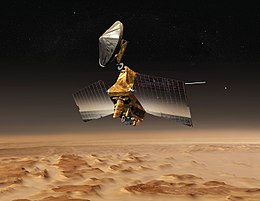Mars Reconnaissance Orbiter

Conceptual image depicting the Mars Reconnaissance Orbiter in an elliptical low Mars orbit
|
|
| Mission type | Mars orbiter |
|---|---|
| Operator | NASA / JPL |
| COSPAR ID | 2005-029A |
| SATCAT № | 28788 |
| Website |
marsprogram www |
| Mission duration | Primary mission: two years Elapsed:11 years, 5 months and 17 days from launch 10 years, 10 months and 19 days (3872 sols) at Mars |
| Spacecraft properties | |
| Manufacturer | Lockheed Martin / University of Arizona / APL / ASI / Malin Space Science Systems |
| Launch mass | 2,180 kg (4,810 lb) |
| Dry mass | 1,031 kg (2,273 lb) |
| Payload mass | 139 kg (306 lb) |
| Power | 2,000.0 watts |
| Start of mission | |
| Launch date | 12 August 2005, 11:43:00 UTC |
| Rocket | Atlas V 401 |
| Launch site | Cape Canaveral SLC-41 |
| Contractor | ILS |
| Orbital parameters | |
| Reference system | Areocentric |
| Regime | Sun-synchronous |
| Inclination | 93 degrees |
| Mars orbiter | |
| Orbital insertion | 10 March 2006, 21:24:00 UTC MSD 46990 12:48 AMT 20 Dhanus 211 Darian |
 |
|
Mars Reconnaissance Orbiter (MRO) is a multipurpose spacecraft designed to conduct reconnaissance and exploration of Mars from orbit. The US$720 million spacecraft was built by Lockheed Martin under the supervision of the Jet Propulsion Laboratory (JPL). The mission is managed by the California Institute of Technology, at the JPL, in La Cañada Flintridge, California, for the NASA Science Mission Directorate, Washington, D.C. It was launched August 12, 2005, and attained Martian orbit on March 10, 2006. In November 2006, after five months of aerobraking, it entered its final science orbit and began its primary science phase. As MRO entered orbit, it joined five other active spacecraft that were either in orbit or on the planet's surface: Mars Global Surveyor, Mars Express, 2001 Mars Odyssey, and the two Mars Exploration Rovers (Spirit and Opportunity); at the time, this set a record for the most operational spacecraft in the immediate vicinity of Mars. Mars Global Surveyor and the Spirit rover have since ceased to function; the remainder remain operational as of September 2016.
MRO contains a host of scientific instruments such as cameras, spectrometers, and radar, which are used to analyze the landforms, stratigraphy, minerals, and ice of Mars. It paves the way for future spacecraft by monitoring Mars' daily weather and surface conditions, studying potential landing sites, and hosting a new telecommunications system. MRO's telecommunications system will transfer more data back to Earth than all previous interplanetary missions combined, and MRO will serve as a highly capable relay satellite for future missions.
...
Wikipedia
